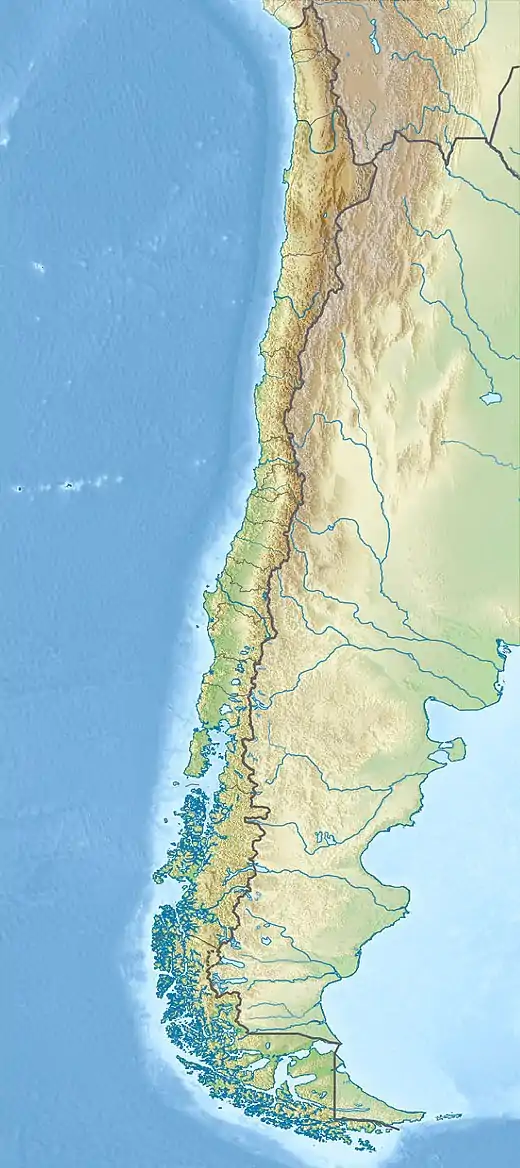Pichilemu Fault
The Pichilemu Fault (Spanish: Falla de Pichilemu),[1] also referred to as the Pichilemu-Vichuquén Fault (Falla de Pichilemu-Vichuquén),[2] is a Chilean geological fault, located in Libertador General Bernardo O'Higgins Region, some kilometers away from Pichilemu,[1] at a depth of 15 kilometres (9.3 mi).[3] The fault is 40 kilometres (25 mi) long and 20 kilometres (12 mi) wide.[3]
| Pichilemu Fault | |
|---|---|
| Falla de Pichilemu | |
 | |
| Etymology | Pichilemu |
| Coordinates | 34°23′30″S 72°00′00″W |
| Country | Chile |
| Region | Libertador General Bernardo O'Higgins |
| State | Cardenal Caro |
| Cities | Pichilemu |
| Characteristics | |
| Length | 40 km (25 mi) |
| Width | 20 km (12 mi) |
| Depth | 15 km (9.3 mi) |
| Strike | 010 |
| Dip | East |
| Tectonics | |
| Plate | South American |
| Status | Active |
| Earthquakes | 2010 Pichilemu (Mw 6.9 & 7.0) |
| Type | Reverse |
| Rock units | Pichilemu metamorphic complex, Neogene sediments |
| Age | Late Paleozoic-recent |
| Orogeny | Andean |
Activity
The fault became reactivated after the February 27, 2010, Chile earthquake, and gave rise to the 2010 Pichilemu earthquake on March 11.[4] At first, it was not known if it was formed during the February earthquake, or if it was just reactivated;[5] however, according to University of Chile geologist José Cembrano, "[it] corresponds to a long-live fault (in a million years time) whose activity had not been detected before."[1] Ancient activity of the fault has been theorized to have occurred in the Late Paleozoic and Late Mesozoic.[6] The reverse fault has a north-northeast to south-southwest strike and dips to the east.[6][7]
"This is a new record that we have found, and it explains why Pichilemu is experiencing so many tremors," the director of the Seismological Service of the University of Chile, Sergio Barrientos told La Tercera on May 22, 2010.[3] "It is not a crack nor an opening. It's a landslide," Barrientos added.[3][8]
The Pichilemu Fault, along with the San Ramón Fault, was as of 2011 being studied by geologists of the University of Chile.[1]
References
- "LAS CINCO FALLAS GEOLÓGICAS MÁS IMPORTANTES QUE CHILE DEBE TENER EN CUENTA" (in Spanish). Punta Arenas, Chile: Radio Polar. April 20, 2011. Retrieved April 23, 2011.
- Arne P. Willner; Peter P. Richter; Uwe Ring (January 2009). "Structural overprint of a late Paleozoic accretionary system in north-central Chile (34°-35°S) during post-accretional deformation" (PDF). Andean Geology. Retrieved November 10, 2010.
- Fernández, O. (May 22, 2010). "Pichilemu tiene falla geológica que genera oleada de réplicas en esa zona" (in Spanish). Santiago, Chile: La Tercera. Archived from the original on March 3, 2012. Retrieved October 30, 2010.
- 杜璐 (Dulu) (May 23, 2010). "Sismos en Chile se deben a falla geológica en Pichilemu". China Internet Information Center (in Spanish). China. Retrieved October 30, 2010.
- Correa, Paula. "Sismólogos advierten sobre la activación de fallas después del terremoto". Radio Universidad de Chile (in Spanish). Santiago, Chile: Universidad de Chile. Retrieved October 30, 2010.
- Farías, M.; Comte, S.; Roecker, D.; Carrizo, D.; Pardo, M. (2011). "Crustal extensional faulting triggered by the 2010Chilean earthquake: The Pichilemu Seismic Sequence". Tectonics. 30 (6010): 1–11. Bibcode:2011Tecto..30.6010F. doi:10.1029/2011TC002888. hdl:10533/132113. S2CID 130357954.
- Muñoz Linford, Pamela Karina (2015). Caracterización sísmica del Antearco Marino en la zona epicentral del mega-terremoto del Maule 2010 (PDF) (MSc. thesis) (in Spanish). Universidad de Chile. pp. 1–71. Retrieved 2018-06-03.
- Leiva, Erika (May 22, 2010). "Falla geológica sería la causante de la oleada de réplicas en Pichilemu". El Tipógrafo (in Spanish). Rancagua, Chile. Retrieved October 30, 2010.